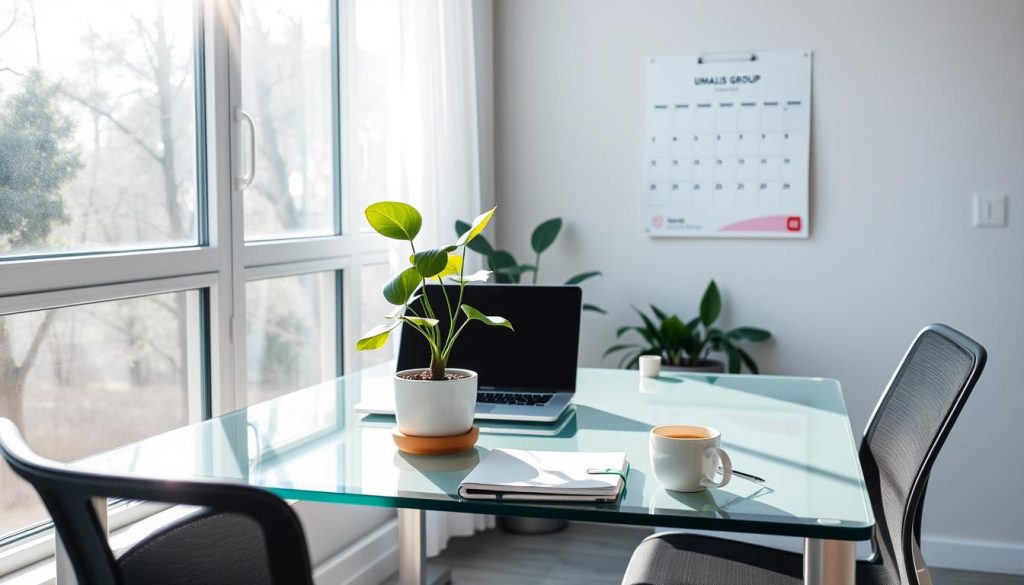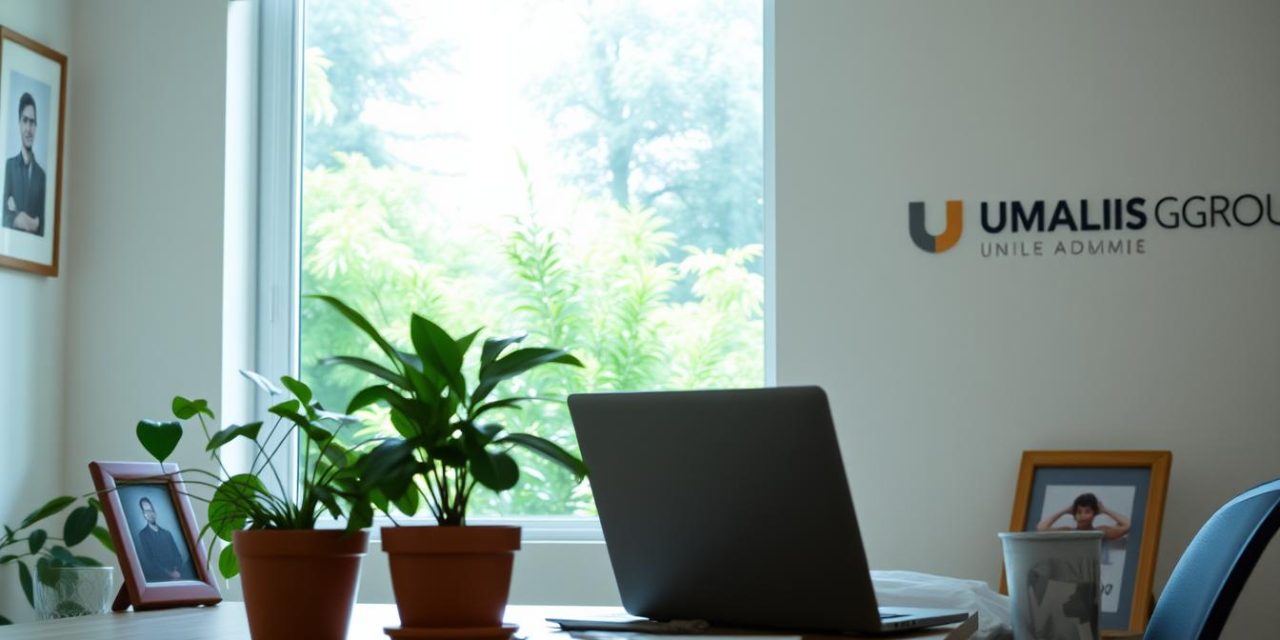Sarah, a marketing manager in Chicago, used to check emails at midnight and skip family dinners to meet deadlines. One day, her 8-year-old daughter asked, « Mom, why do you always look at your phone instead of me? » That moment made her realize she needed a healthy work-life balance.
Like 60% of U.S. employees, Sarah struggled with blurred boundaries between work and personal time. Remote work made it harder to disconnect. But small changes—like setting clear work hours and weekly priorities—helped her regain control.
Balance isn’t about perfection. It’s about intentional choices that fit your career and life goals. Whether you’re an entrepreneur or a corporate professional, sustainable habits make all the difference.
Table of Contents
Key Takeaways
- 60% of professionals face challenges managing work and personal life.
- Remote work can blur boundaries without clear routines.
- Personalized strategies work better than one-size-fits-all solutions.
- Small, consistent habits lead to long-term success.
- Professional coaching can provide tailored guidance.
What Is Work-Life Balance and Why Does It Matter?
The pandemic reshaped priorities, with 41% of professionals now valuing personal time over higher salaries. Work-life balance isn’t rigid—it’s a dynamic equilibrium between career demands and personal life. Think of it as a scale that adjusts to your goals, energy, and seasons of life.
Businesses feel the impact too. Replacing an employee costs £30k on average, per Oxford Economics. Companies promoting balance see 52% higher engagement and retain talent longer.
Modern professionals often prefer work-life integration. This approach blends tasks flexibly—like answering emails early to attend a child’s recital later.
| Metric | Impact of Balance |
|---|---|
| Employee Retention | Reduces turnover costs by £30k per hire |
| Absenteeism | Drops by 60% in balanced workplaces |
| Leadership Effectiveness | Teams report 52% higher engagement |
Leaders set the tone. A manager who unplugs at 6 PM gives permission for others to do the same. Healthy work-life habits aren’t perks—they’re productivity boosters.
Signs Your Work-Life Balance Is Out of Sync
Your body and mind send signals when work demands overshadow personal well-being. Ignoring these warnings can lead to poor work-life balance, affecting everything from sleep to job performance. Recognizing the signs early helps you course-correct before stress escalates.
Physical and Mental Red Flags
Chronic fatigue tops the list. If coffee becomes a lifeline or sleep feels elusive, your workload may be unsustainable. Mental Health America reports 76% of professionals link stress to anxiety or depression symptoms.
Other warning signs include:
- Frequent illnesses (immune system decline)
- Difficulty concentrating or making decisions
- Irritability with colleagues or family
Professional and Personal Consequences
Persistent burnout reduces productivity and creativity. A UCL study found working 3+ overtime hours daily increases cardiac risk by 60%. Relationships suffer too—missed birthdays or snapped responses erode trust.
| Sign | Impact |
|---|---|
| Chronic fatigue | Lower productivity, higher errors |
| Stress-related illness | Increased sick days |
| Emotional exhaustion | Higher turnover risk |
Prioritizing physical mental health isn’t selfish—it’s essential for sustained success. Small adjustments, like scheduled breaks or delegation, can restore equilibrium.
Practical Tips to Improve Work-Life Balance
French labor laws now protect employees’ ‘right to disconnect’—should you adopt this practice? Small, intentional changes can transform how you manage time and energy. Start with these expert-backed strategies.

Set Boundaries and Stick to Them
Clear limits prevent burnout. Try these tactics:
- Device segregation: Use separate phones or apps for work vs. personal life.
- Communication rules: Set « no-email hours » after 6 PM (like France’s labor law).
- Physical workspace: Designate a work zone—even if it’s just a corner desk.
77% of professionals who enforce boundaries report higher focus during work hours.
Prioritize Self-Care and Mindfulness
Your energy levels impact performance. The Pomodoro Technique—25-minute focused bursts with 5-minute breaks—boosts efficiency by 40%. Pair it with:
- Daily 10-minute meditation (reduces stress by 30%).
- Short walks to reset creativity.
84% of experts say saying « no » to non-essential tasks preserves mental health.
Leverage Time-Management Strategies
Structure your day for maximum impact. Structured routines like time-blocking help 87% of remote workers maintain balance. Try:
- Top 3 priorities each morning.
- Batch similar tasks (e.g., meetings on Tuesdays).
- Weekly reviews to adjust goals.
55% of U.S. employees underuse vacation days—schedule downtime like any critical meeting.
Navigating Work-Life Balance While Working Remotely
Remote work surged from 20% to 70% post-pandemic, reshaping how professionals manage their time. A Tower Perrin survey found teams with engaged remote workers saw 19.2% higher operating income. But without office boundaries, blending work hours and personal time becomes tricky.
Spatial Separation for Small Homes
Even in small home spaces, define clear working home zones. Try:
- A foldable desk to physically « close » work at day’s end.
- Room dividers or rugs to mark dedicated areas.
Transition Rituals Replace Commutes
A 10-minute « fake commute » walk signals your brain to switch modes. Other rituals:
- Brewing tea to mimic office coffee breaks.
- Changing outfits to reinforce schedule shifts.
| Challenge | Solution |
|---|---|
| Shared devices | Use separate user profiles for work personal life. |
| Isolation | Join virtual coworking sessions for social interaction. |
Stick to fixed work hours. Async tools like Slack or Loom reduce real-time pressure. Finally, invest in an ergonomic chair—your back will thank you.
How Employers Can Support Work-Life Balance
Forward-thinking companies are redefining success by prioritizing employee well-being alongside productivity. A Culture Amp study found that 75% of professionals value flexibility when choosing a job—and employers who deliver see 40% lower turnover.
Promote Flexible Work Arrangements
Flexibility boosts retention and morale. Consider these proven models:
- Results-Only Work Environment (ROWE): Measure output, not hours. Teams at Best Buy reported 35% higher productivity.
- Staggered shifts: Accommodate global teams or caregivers with early/late options.
- Job sharing: Two professionals split one role, maintaining continuity while reducing burnout.
According to SHRM, companies offering such options cut absenteeism by 25%.
Foster a Culture of Respect
Trust is the foundation. Leaders who model boundaries—like avoiding late-night emails—create psychological safety. Tactics include:
- Encouraging employees to use PTO without guilt.
- Recognizing achievements beyond overtime (e.g., innovation or mentorship).
As highlighted in this study, supportive cultures see 50% higher satisfaction rates. Small gestures, like meeting-free Fridays, signal that the company values personal time.
The Link Between Work-Life Balance and Productivity
Productivity isn’t about working longer—it’s about working smarter with focused energy. A Kansas Journal of Medicine study found that well-being boosts performance by 21%, while stressed teams operate at just 72% capacity.

Mastering Focused Work
Multitasking reduces output by 40%. Instead, try:
- Deep work: 90-minute uninterrupted sessions for complex tasks.
- Time-blocking: Schedule priorities first, like Elon Musk’s 5-minute slots.
Optimizing Meetings and Emails
Inefficient meetings waste $37 billion annually. Apply these fixes:
| Issue | Solution |
|---|---|
| Low ROI meetings | Require agendas and 15-minute caps |
| Email overload | Batch-check 3x/day; use templates |
Parkinson’s Law shows tasks expand to fill allotted time. Set tighter deadlines to combat procrastination. For more time management strategies, explore our guide.
Energy management trumps time management. Match tasks to your peak hours—creative work in mornings, admin in afternoons. Your brain will thank you.
Health Benefits of a Balanced Lifestyle
Chronic stress costs U.S. businesses $300 billion annually in healthcare and lost productivity. A balanced lifestyle isn’t just about feeling better—it’s a health imperative with measurable impacts. The CDC links high cortisol levels to 60% of workplace absences.
Simple changes yield dramatic results. For example, professionals who take regular vacations have a 30% lower risk of heart disease. Here’s how to harness these benefits:
- Cortisol control: 10-minute meditation breaks reduce stress hormones by 27%.
- Sleep optimization: Consistent bedtimes improve deep sleep cycles by 31%.
- Nutritional synergy: Omega-3s boost cognitive performance by 15%.
Social connections matter too. Employees with strong workplace relationships report 40% fewer sick days. Their immune systems respond faster to threats.
| Health Factor | Improvement Strategy | Impact |
|---|---|---|
| Mental health | Weekly digital detoxes | 52% lower anxiety |
| Physical health | 30-minute daily walks | Reduces diabetes risk by 41% |
For tailored stress reduction techniques, explore our guide on mindfulness and relaxation. Remember, small habits create lasting health dividends.
Real Stories: Professionals Who Mastered Balance
Chris Chancey built a 7-figure recruiting firm while coaching his kids’ soccer team—here’s how. The Amplio Recruiting CEO schedules client calls between 9 AM-2 PM, reserving afternoons for family. « Productivity isn’t about hours logged, » he notes. « It’s about designing your day around what matters most. »
Heather Monahan of Boss In Heels takes a different approach. The media entrepreneur blocks quarterly digital detoxes. No emails, no social media—just focused creative time. Her team knows these periods are sacred for strategic planning.
Other professionals found their own way to thrive:
- A tech executive condensed meetings to Wednesdays only, freeing 11 hours weekly for deep work.
- Consultant Raj Patel color-codes his calendar: blue for client work, green for personal time.
- Remote worker Sofia Mendez alternates between coworking spaces and beach cafes to stay inspired.
For working parents, boundaries are key. Marketing director Lila Chen marks « family first » blocks in her shared calendar. Colleagues see these slots as unavailable—just like client meetings.
One company tested radical change: a 4-day workweek trial. Results surprised everyone. Productivity rose 23%, and 92% of people reported better mental health. The secret? Structured focus sessions and clear expectations.
These stories prove there’s no single right way. Whether through strict scheduling or flexible rhythms, professionals are rewriting the rules. As Chancey puts it: « When your life and career align, success follows naturally. »
Conclusion
Creating harmony between career and personal time starts with small, intentional steps. Companies prioritizing work-life balance see 52% higher engagement—proof that sustainable habits fuel success.
Focus on micro-changes: time-blocking, digital detoxes, or saying « no » to non-essentials. Our free self-assessment tool helps identify where to improve work-life alignment.
For tailored strategies, explore our coaching consultations. Remember, a healthy work-life rhythm isn’t about perfection—it’s progress, one step at a time.
FAQ
What is the definition of work-life balance?
It’s the harmony between professional responsibilities and personal well-being. This means managing time and energy so neither work nor personal life dominates.
Why is work-life balance important for mental health?
Poor balance leads to stress, burnout, and anxiety. Prioritizing both work and personal needs improves focus, happiness, and long-term health.
How can I set boundaries between work and home?
Define clear work hours, avoid after-hours emails, and create a dedicated workspace. Communicate limits to colleagues and stick to them.
What are signs of poor work-life balance?
Constant fatigue, irritability, declining productivity, and neglecting hobbies or relationships signal imbalance. Physical symptoms like headaches may also appear.
How can employers help employees achieve balance?
Offer flexible schedules, remote options, and mental health support. Encourage breaks and respect off-hours to build a healthy company culture.
Does remote work improve work-life balance?
It can, but blurred lines between home and office may increase stress. Set routines, take breaks, and separate work zones to maintain structure.
How does work-life balance boost productivity?
Rested, motivated employees perform better. Balance reduces burnout, increases creativity, and leads to higher-quality output in fewer hours.
What role does self-care play in balance?
Exercise, sleep, and hobbies recharge energy. Mindfulness practices like meditation also help manage stress and maintain focus.





